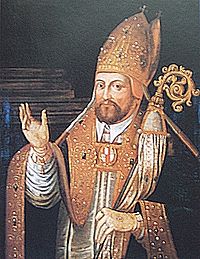
Back أسقف كاثوليكي Arabic اسقف كاتوليكى ARZ Obispo kan Simbahan Katoliko BCL Каталіцкі біскуп Byelorussian Bisbe (Església Catòlica) Catalan Bischof (Römisch-katholische Kirche) German Évêque catholique French Uskup di Gereja Katolik ID 司教 Japanese 로마 가톨릭교회의 주교 Korean



In the Catholic Church, a bishop is an ordained minister who holds the fullness of the sacrament of holy orders and is responsible for teaching doctrine,[1] governing Catholics in his jurisdiction,[2] sanctifying the world[3] and representing the Church.[4][5] Catholics trace the origins of the office of bishop to the apostles, who it is believed were endowed with a special charism and office by the Holy Spirit at Pentecost.[6] Catholics believe this special charism and office has been transmitted through an unbroken succession of bishops by the laying on of hands in the sacrament of holy orders.[7]
Diocesan bishops—known as eparchial bishops in the Eastern Catholic Churches—are assigned to govern local regions within the Catholic Church known as dioceses in the Latin Church and eparchies in the Eastern Churches. Bishops are collectively known as the College of Bishops and can hold such additional titles as archbishop, cardinal, patriarch, or pope. As of 2020, there were approximately 5,600 living bishops total in the Latin and Eastern churches of the Catholic Church.[8]
Bishops are always men.[9] In addition, canon 180 of the Code of Canons of the Eastern Churches requires that a candidate for the Eastern episcopacy should (canon 378 § 1 of the 1983 Code of Canon Law states almost the same requirements):
- demonstrate solid faith, good morals, piety, zeal for souls and prudence;
- enjoy a good reputation;
- not be bound by a matrimonial bond;
- be at least thirty-five years old;
- ordained a presbyter for at least five years;
- possess a doctorate or licentiate in some sacred science or at least be an expert in it.
- ^ "Catechism of the Catholic Church – Christ's Faithful – Hierarchy, Laity, Consecrated Life". Vatican.va. 1946-02-20. Retrieved 2014-04-01.
- ^ "Catechism of the Catholic Church – Christ's Faithful – Hierarchy, Laity, Consecrated Life". Vatican.va. 1946-02-20. Retrieved 2014-04-01.
- ^ "Catechism of the Catholic Church – Christ's Faithful – Hierarchy, Laity, Consecrated Life". Vatican.va. 1946-02-20. Retrieved 2014-04-01.
- ^ "Catechism of the Catholic Church – The sacrament of Holy Orders". Vatican.va. Archived from the original on 2014-04-24. Retrieved 2014-04-01.
- ^ "CCC – PART 1 SECTION 2 CHAPTER 3 ARTICLE 9 PARAGRAPH 3". Vatican.va. 1975-12-14. Retrieved 2014-04-01.
- ^ "Catechism 1556". Retrieved 6 October 2014.
- ^ "Catechism 1555–1556". Retrieved 6 October 2014.
- ^ "Living Bishops". Catholic-Hierarchy.org. David M. Cheney. Retrieved 23 January 2015.
- ^ "APOSTOLIC LETTER ORDINATIO SACERDOTALIS OF JOHN PAUL II TO THE BISHOPS OF THE CATHOLIC CHURCH ON RESERVING PRIESTLY ORDINATION TO MEN ALONE". Libreria Editrice Vaticana. Retrieved 30 May 2014.
